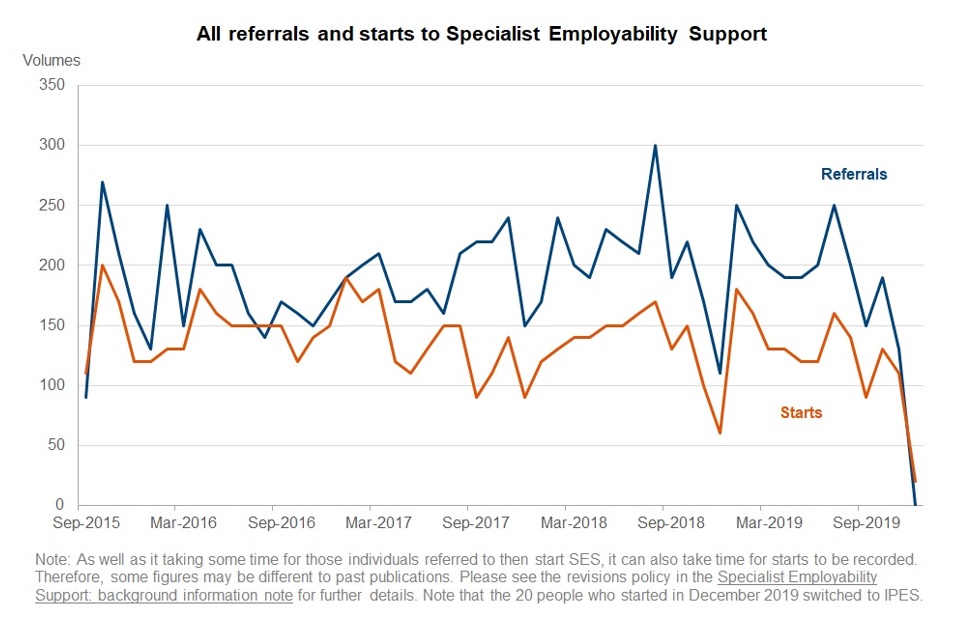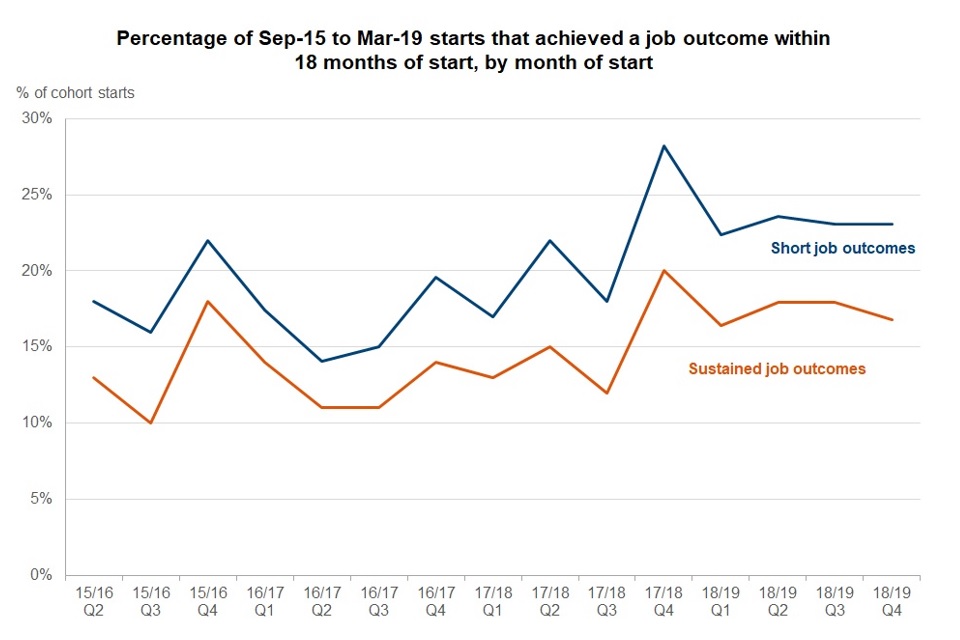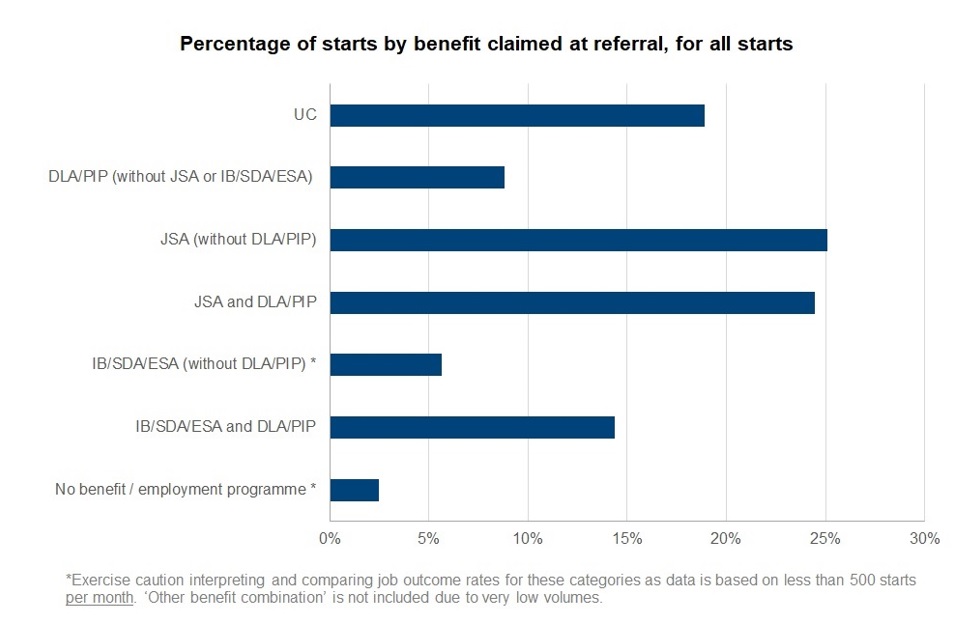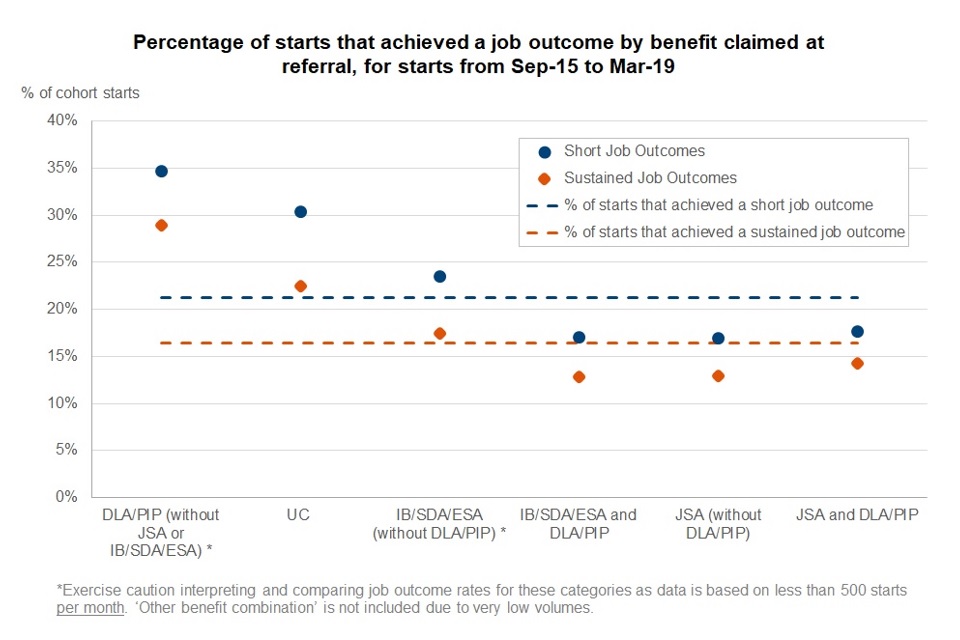Specialist Employability Support statistics to September 2020
Published 25 November 2020
Applies to England, Scotland and Wales
This is the last publication in this series.
Main stories
The key points from this release covering Specialist Employment Support (SES) to September 2020 are:
- there were a total of 9,720 referrals and 7,020 starts to the programme
- more than two thirds of people starting SES were claiming Jobseeker’s Allowance or Universal Credit
- of the 6,000 starts to SES between September 2015 and March 2019, 1,270 (21%) achieved a job lasting at least 13 weeks and 980 (16%) achieved a job lasting at least 26 weeks
1. What was Specialist Employability Support?
SES was a voluntary programme for disabled people with the highest support needs. SES was delivered by providers funded by the government. Three (originally 4) providers offered national pan disability support and 2 providers offered national specialist sensory support.
Support was offered to SES participants in line with their individual work focused Individual Support Plans and job goals. Providers tailored their provision to meet the employment needs of each individual and the support they provided included the following:
- helping with job search and doing the job
- helping with identifying appropriate networks, charities, advocates etc. to help meet specific employment needs
- work-related independence skills for example, mobility training and assistive technology
- appropriate medical support including counselling and mentoring
- helping establish work solutions and providing advice on managing a disability in the workplace
- offering in-depth personal development programmes tailored to the needs of disabled people
- using links with local employers to arrange work experience, work placements or job shadowing
- working with and acquiring funding if required from social services, healthcare providers and Local Authorities (LAs)
- liaising with Jobcentre Plus to assist individuals in gaining any support through Access to Work
Referrals began in September 2015 with 2 strands of support:
- SES ‘Main’ (intensive, end-to-end employability provision)
- SES ‘Start Back’ (a shorter term provision)
From September 2017, Start Back provision was not included separately but providers offered the support that was originally provided in Start Back through Main Provision. Statistics for starts and referrals between September 2015 and August 2017 therefore include both SES ‘Main’ and SES ‘Start Back’, whereas the corresponding statistics from September 2017 are for SES ‘Main’ extension only.
Referrals ended in November 2019, with delivery of support ending in August 2020. Given the effects of COVID-19, and that the programme delivery would naturally end in January 2021, the Department worked with Providers to agree the earlier end date of August 2020.
Providers worked with participants still being supported by SES at this point to ensure they were all offered suitable, alternative, longer support, such as the Work and Health Programme or Intensive Personalised Employment Support.
The Sensory providers (Doncaster Deaf Trust and Royal National College) are continuing non-contractual support for their customers within their organisation.
2. What do these statistics show?
This is the final statistical publication on SES. It contains figures on referrals, starts and job outcomes from the start of the programme in September 2015 up to and including September 2020. Job outcomes include:
- jobs which last at least 13 weeks: short job outcomes
- jobs maintained for at least 26 weeks over a 30-week period: sustained job outcomes
This publication also covers provider level performance showing the job outcomes achieved to date, compared to expectations of 30% for short job outcomes and 18% for sustained job outcomes, as well as employment history of SES participants, which is measured as the percentage of days in employment during the 2 years prior to starting SES.
We say that a SES participant had:
- high employment history if over 50% of days were spent in employment during the 2 years prior to start
- medium employment history if 21% to 50% of days were spent in employment during the 2 years prior to start
- low employment history if 1% to 20% of days were spent in employment during the 2 years prior to start
- no employment history if 0% of days were spent in employment during the 2 years prior to start
For further information see the Specialist Employability Support: background information note.
3. Referrals and Starts
72% of those referred to SES subsequently start on the programme.

Main findings
The number of starts to Specialist Employability Support has been fairly constant over the last 2 years averaging at approximately 130 per month.
In 2019 to 2020 there were:
- 1,500 referrals
- 1,030 starts
For full data see Table 1 in the accompanying data tables.
4. Job Outcomes
The majority of job outcomes were achieved within 18 months but some participants took more than 2 years for both short job outcomes and sustained job outcomes.

Main findings
Of those who started SES between September 2015 and September 2018
- 21% achieved a short job outcome
- 16% achieved a sustained job outcome
Of the short outcomes achieved by this group 77% were achieved in 12 months and 95% within 18 months.
Of the sustained outcomes achieved, 58% were achieved in 12 months and 89% within 18 months.
For full data see Table 2 in the accompanying data tables.
The proportion of starts that achieved a short job outcome and a sustained job outcome over time remained fairly constant.

Main findings
The proportion of starts that result in an achieved job outcome varies from one quarter to the next. This is partly due to the relatively small numbers involved. The latest year has seen an increase in the job outcome rates. Of the latest year of starts for which sufficient tracking data is available (2018 to 2019), 23% achieved a short job outcome and 17% achieved a sustained job outcome within 18 months. This is an increase of 2 percentage points for both the short job outcome rate and sustained job outcome rate compared to the previous year (2017 to 2018 starts).
For full data see Table 3 in the accompanying data tables.
5. Benefit claimed at the point of referral

Main findings
More than two thirds of people who volunteered for Specialist Employability Support were claiming Jobseeker’s Allowance (JSA) (50%) or Universal Credit (UC) (19%).
Variation in job outcome rate by benefit claimed

Main findings
For the different benefit types, the proportion of SES starts that achieved a job outcome varies between:
- 17% and 35% for short job outcomes
- 13% and 29% for sustained job outcomes
Overall short job outcome figures and sustained job outcome figures are based on cohorts starting from September 2015 to March 2019.
For full data see Table 4 in the accompanying data tables.
6. Employment History
The vast majority of SES participants had no recorded employment in the two years prior to starting.

Groups with more employment history achieved higher proportions of both short job outcomes and sustained job outcomes.

Main findings
The vast majority of Specialist Employability Support participants had no recorded employment in the 2 years prior to start. Only a third had some employment in those 2 years.
Those with no employment achieved the lowest proportion of both short and sustained job outcomes.
Groups with more employment history in the 2 years prior to start achieved higher proportions of both short job outcomes and sustained job outcomes.
For those who spent over 50% of their previous 2 years in employment, over 80% of short job outcomes were converted into sustained job outcomes.
Overall short job outcome figures and sustained job outcome figures are based on cohorts starting from September 2015 to March 2019.
For full data see Table 5 in the accompanying data tables.
7. Provider level performance


Main findings
These charts show the job outcome performance of SES providers over the entire contract period to September 2020.
Based on the evidence available before the programme was launched, the Department set minimum performance expectations for the number of participants that would achieve a job outcome. These were included in the Invitation to Tender (ITT) for the commercial process, and expect 30% of participants to achieve a Short Job Outcome and 18% of participants to achieve a Sustained Job Outcome.
From September 2015 to September 2020, around 1,430 participants on the SES programme achieved a short job outcome compared to an expectation of 2,090 participants achieving one. This means total SES performance was 69% of expectation.
Performance varies between providers. For most, the number of short job outcomes achieved was below the number expected, ranging from 46% to 76% of expectation.
Over the same period, a total of 1,080 SES participants achieved a sustained job outcome compared to an expectation of 1,230. This means total SES sustained job outcome performance was 88% of expectation.
Two providers have exceeded expectations for sustained job outcomes, with the number of sustained outcomes achieved ranging from 64% to 108% of the expected outcomes.
For full data see Table 6 in the accompanying data tables.
The Department for Work and Pensions (DWP) set minimum performance expectations for SES on the number of participants that would get a job as part of developing the Business Case for the programme. For more information on this and on what these figures mean and how they are calculated, please see the Specialist Employability Support: background information note.
8. About these statistics
This is the official government statistical release on the Specialist Employability Support programme for September 2020. It contains in-month data on referrals, starts and job outcomes for Specialist Employability Support up to and including September 2020, and cohort analysis for starts are up to and including March 2019.
The statistics are currently an experimental statistical series, which means it is not assessed as a National Statistic. All official statistics should comply with all aspects of the Code of Practice for Official Statistics. Statistics are awarded National Statistics status following an assessment by the Office for Statistics Regulation. The Office for Statistics Regulation considers whether the statistics meet the highest standards of Code compliance, including the value they add to public decisions and debate. National Statistics status means that official statistics meet the highest standards of trustworthiness, quality and public value.
Data for these statistics is derived from the Labour Market System (LMS) Opportunity Type database, the Provider Referrals and Payments System (PRaP), the DWP National Benefit Database (NBD) and the Work and Pensions Longitudinal Study (WPLS).
For more information on revisions see the Specialist Employability Support: background information note.
For in-month-figures, data is from September 2015 to September 2020.
For job outcome figures, data is available for starts from September 2015 to March 2019. This is to ensure all cohorts have at least 18 months to achieve job outcomes.
9. Where to find out more
Read information about Specialist Employability Support
Read more information about the statistics in the Specialist Employability Support background information note.
